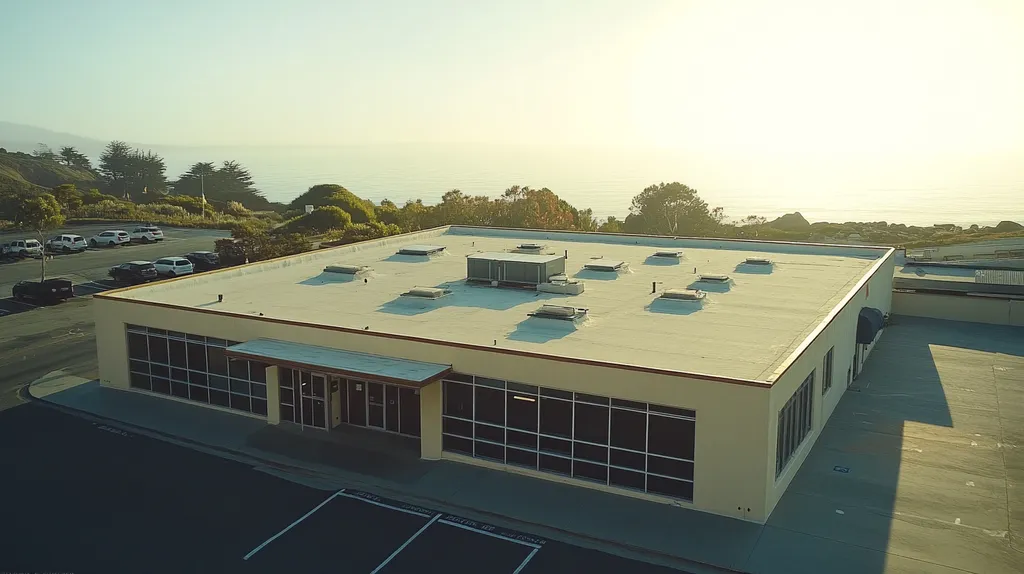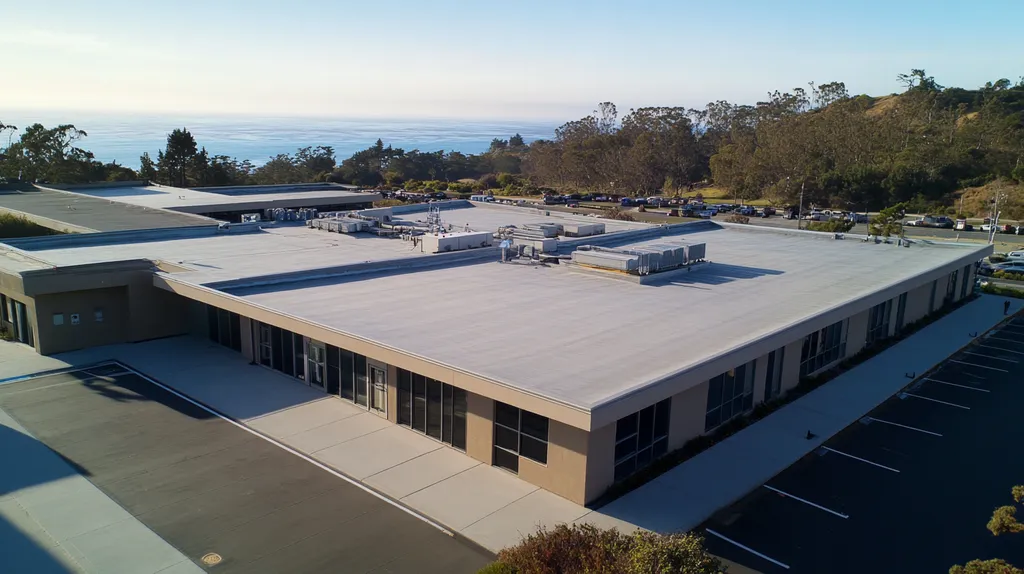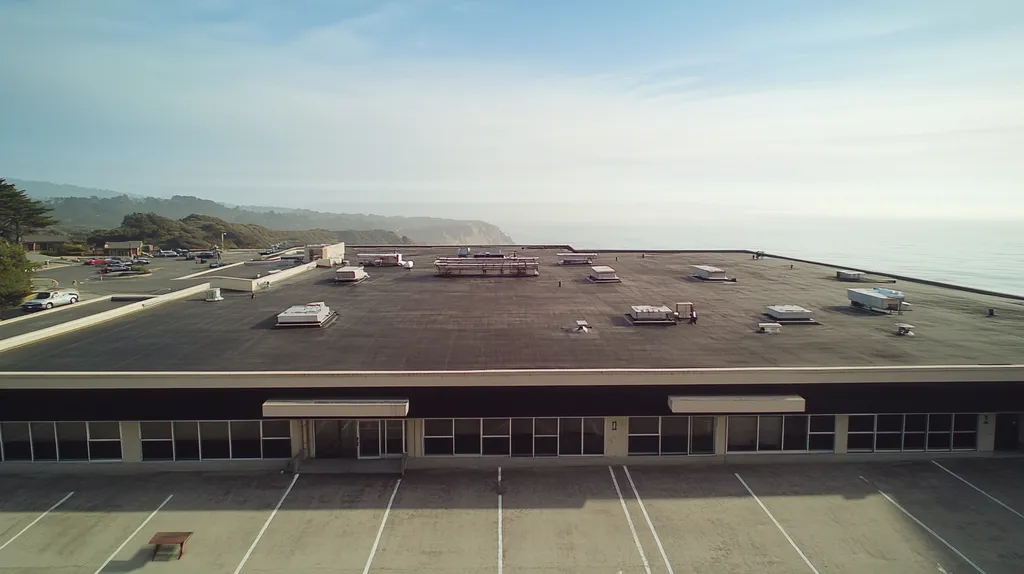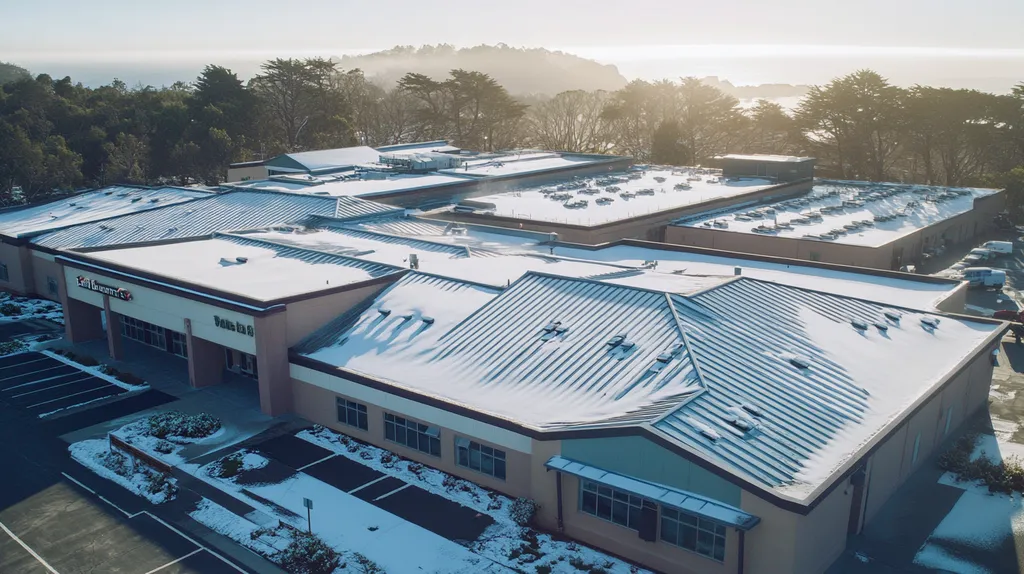Welcome to today’s Battle Royale featuring two roofing heavyweights: “TPO” in the east corner versus “PVC” in the west!
Tonight’s showdown pits these contenders against each other across six punishing rounds designed to test every aspect of their performance for Commercial Roof Warranty Options.
At stake? Millions in potential costs, decades of building protection, and the critical performance demands of modern commercial and industrial facilities.
Our professional judging panel will evaluate each round on technical merit, real-world performance, and value delivery. After all six rounds, we’ll declare our ultimate champion.
Ladies and gentlemen, facility managers and building owners… it’s time to rumble!
ROUND 1: INITIAL COSTS & INSTALLATION
When selecting a commercial roofing system, the initial investment can range from $250,000 to over $1 million for a typical 50,000-square-foot facility. These costs ripple through budgets for years to come, affecting everything from maintenance schedules to warranty coverage. Making the wrong choice between TPO and PVC can lead to premature replacement, unexpected repairs, or inadequate protection for your facility.
Material Expenses
TPO membrane typically costs 30-40% less than PVC, with prices ranging from $3-7 per square foot for materials alone. This significant cost difference makes TPO an attractive option for projects with tight budgets or buildings with shorter planned operational lifespans.
PVC materials command premium pricing between $5-10 per square foot, reflecting their enhanced durability and chemical resistance. While the upfront cost is higher, PVC’s superior resistance to environmental factors and chemicals can justify the investment for industrial facilities or buildings in harsh environments.
The substantial price difference gives TPO a clear ADVANTAGE in material expenses, particularly for budget-conscious projects where immediate costs are a primary concern.
Installation Complexity
Standard manufacturer warranties cover material defects but not installation errors, making proper installation crucial for long-term performance. TPO installation requires less specialized training and fewer labor hours, potentially reducing overall project costs. (source: Owens Corning)
PVC installation demands more experienced crews and specialized certification, particularly for extended warranty coverage. The complex welding requirements and temperature management needs can increase labor costs and require more specialized equipment.
The simpler installation requirements and lower labor demands give TPO another clear ADVANTAGE in this category.
Project Timeline
TPO installations typically complete 25-35% faster than comparable PVC projects due to simpler installation procedures. This efficiency translates to less disruption for building operations and lower labor costs.
PVC installations require more precise workmanship and additional time for proper seam welding and quality control. The extended timeline can impact building operations and increase overall project costs.
The faster completion time and reduced operational disruption gives TPO the ADVANTAGE in project timelines.
ROUND 1 WINNER: TPO
ROUND 2: DURABILITY & LIFESPAN
Every commercial roof faces a daily battle against UV rays, temperature swings, chemical exposure, and foot traffic. For a typical 50,000-square-foot facility, premature roof failure can trigger repair costs exceeding $500,000 – not counting business interruption and inventory damage.
Understanding how TPO and PVC perform over time isn’t just about avoiding leaks – it’s about protecting your facility’s operations, equipment, and bottom line for decades to come.
Material Resilience
TPO membranes offer solid baseline performance with good UV resistance and heat reflection properties. Their welded seams create a reliable barrier against water infiltration when properly installed.
However, TPO’s chemical composition can make it vulnerable to prolonged exposure to industrial chemicals and petroleum products. Some TPO formulations have also shown accelerated degradation in extremely hot climates.
PVC membranes demonstrate superior chemical resistance and maintain their physical properties longer than TPO. Their inherent flexibility helps them handle building movement and thermal cycling without compromising seam integrity.
Due to its enhanced chemical resistance and proven long-term performance, PVC gains the ADVANTAGE in material resilience.
Impact & Puncture Resistance
TPO membranes provide adequate puncture resistance for typical commercial applications. Their thermoplastic nature allows for heat-welded repairs when damage does occur.
Regular foot traffic and dropped tools can gradually weaken TPO membranes, especially in high-traffic maintenance areas. This vulnerability increases as the membrane ages and becomes less flexible.
PVC offers superior tear and puncture resistance throughout its service life. Its molecular structure maintains flexibility and damage resistance even after decades of exposure.
The consistent long-term durability gives PVC the ADVANTAGE in impact resistance.
Service Life Expectations
TPO roofs typically deliver 15-20 years of reliable service when properly installed and maintained. This lifespan can be adequate for buildings with planned renovations or ownership transitions.
Environmental factors and maintenance practices significantly impact TPO performance. Harsh conditions or irregular maintenance can reduce service life by 25% or more.
PVC systems regularly achieve 25-30 year lifespans, with many installations exceeding three decades. Their proven track record of longevity makes them ideal for facilities planning long-term operations.
The documented longer service life gives PVC the ADVANTAGE in expected lifespan.
ROUND 2 WINNER: PVC
ROUND 3: PERFORMANCE FACTORS
Every day, commercial roofs face punishing conditions that can lead to catastrophic failures. For a typical 50,000-square-foot facility, poor performance can result in energy waste exceeding $100,000 annually, not to mention potential inventory damage from leaks. Understanding how TPO and PVC membranes perform under real-world conditions is crucial for protecting your investment.
Weather Resistance
In commercial roofing, weather resistance directly impacts maintenance costs and system longevity. TPO membranes offer strong baseline UV protection and heat reflection, helping maintain consistent indoor temperatures through seasonal changes.
However, TPO can show accelerated aging in extremely hot climates or areas with high rainfall. Some formulations become brittle over time, particularly in regions with dramatic temperature swings.
PVC membranes demonstrate exceptional resistance to all weather conditions, maintaining flexibility and structural integrity even after decades of exposure. Their molecular structure actively resists degradation from UV rays and moisture.
The superior long-term weather endurance gives PVC the ADVANTAGE in this category.
Chemical Resistance
Industrial environments often expose roofing materials to harsh chemicals and pollutants. TPO provides adequate protection against common environmental contaminants but can degrade when exposed to certain industrial chemicals or petroleum products.
TPO’s resistance to grease and mild acids makes it suitable for standard commercial applications. However, prolonged exposure to stronger chemicals can compromise its structural integrity.
PVC excels in chemical resistance, maintaining its protective properties even when exposed to industrial solvents, oils, and acids. This inherent resistance makes it ideal for manufacturing facilities and chemical plants.
The comprehensive chemical protection gives PVC the ADVANTAGE in this category.
Performance Consistency
Long-term performance reliability directly affects maintenance costs and replacement timing. TPO membranes can deliver 20 years of service life when properly installed and maintained, performing consistently in moderate conditions. (source: FiberTite)
However, TPO performance can vary significantly between manufacturers and formulations. Environmental stressors may accelerate wear patterns unpredictably.
PVC demonstrates remarkably consistent performance across different manufacturers and installation conditions. Its proven track record of reliable protection makes long-term performance more predictable.
The reliable long-term performance gives PVC the ADVANTAGE in this category.
ROUND 3 WINNER: PVC
ROUND 4: MAINTENANCE REQUIREMENTS
For a typical 50,000-square-foot commercial facility, maintenance oversights can trigger catastrophic failures costing upwards of $250,000 in emergency repairs. Beyond the immediate repair costs, business interruption and inventory damage can multiply these expenses several times over.
Understanding the maintenance demands of TPO versus PVC roofing systems isn’t just about scheduling inspections – it’s about protecting your facility’s operational continuity and bottom line for decades to come.
Routine Inspection Requirements
TPO roofing systems demand quarterly inspections focusing on seam integrity, drainage patterns, and surface degradation. The relatively simple material composition makes these inspections straightforward, allowing in-house maintenance teams to handle most routine checks.
Early detection of issues in TPO systems can prevent most major failures through simple repairs. However, missed maintenance windows can accelerate deterioration, particularly around mechanical equipment and high-traffic areas.
PVC systems require semi-annual professional inspections, with particular attention to chemical exposure areas and weld integrity. Their superior durability means fewer emergency repairs, but when issues do arise, they typically demand specialized expertise.
The simpler inspection requirements and ability to use in-house teams gives TPO the ADVANTAGE in this category.
Repair Complexity
TPO repairs generally involve straightforward procedures that experienced maintenance teams can handle effectively. Most common issues can be addressed with heat welding and patch applications, requiring minimal specialized equipment.
The material’s flexibility allows for easier patch integration, though proper temperature control remains crucial. Many repairs can be completed within standard maintenance windows, minimizing operational disruption.
PVC repairs demand more technical expertise and specialized welding equipment. While repairs are less frequent due to the material’s durability, when needed, they typically require certified contractors and extended facility downtime.
The accessibility of repair procedures gives TPO another clear ADVANTAGE in this category.
Long-term Maintenance Costs
TPO maintenance costs typically range from $0.10 to $0.15 per square foot annually for routine care. Regular maintenance provides essential protection that helps property owners maintain their warranty coverage and extend system lifespan. (source: DD Proofing)
PVC systems generally cost $0.08 to $0.12 per square foot annually for standard maintenance. Their inherent durability and chemical resistance reduce the frequency of repairs and extend intervals between major maintenance events.
While TPO requires more frequent attention, the lower cost of individual maintenance events balances against PVC’s need for specialized service providers. This results in a TIE for long-term maintenance costs.
ROUND 4 WINNER: TPO
ROUND 5: SUSTAINABILITY CREDENTIALS
For a typical 50,000-square-foot commercial facility, sustainable roofing choices can reduce energy costs by up to $75,000 annually while protecting our environment. With increasing regulations around building sustainability and rising energy costs, choosing between TPO and PVC now carries significant financial and environmental implications.
Beyond immediate cost savings, sustainable roofing decisions impact everything from carbon footprint to long-term facility operating expenses. Making the wrong choice can lock facilities into decades of unnecessary energy waste and environmental impact.
Environmental Impact
TPO roofing systems offer significant environmental advantages through their manufacturing process, which requires less energy and produces fewer harmful byproducts than traditional materials. Their lightweight nature also reduces transportation emissions and installation energy requirements.
Modern TPO formulations achieve high environmental performance ratings while maintaining structural integrity. However, some compounds used in TPO production still raise environmental concerns among sustainability experts.
PVC manufacturing creates more environmental challenges, including the release of dioxins and other harmful chemicals. While newer production methods have reduced these impacts, PVC still carries a larger environmental footprint than TPO.
The cleaner production process and reduced environmental impact gives TPO the ADVANTAGE in this category.
Energy Efficiency
TPO membranes excel in reflecting solar radiation, with most products achieving reflectivity ratings above 85%. This superior reflectivity can reduce cooling costs by 25-35% during peak summer months.
The material maintains its reflective properties longer than many alternatives, requiring less frequent cleaning or recoating to maintain energy performance. This consistency helps facilities maintain predictable energy costs.
PVC systems also offer good reflectivity but typically achieve slightly lower ratings than TPO. Their reflective properties can degrade faster in harsh environments, potentially reducing energy efficiency over time.
The superior and more consistent reflectivity gives TPO the ADVANTAGE in energy efficiency.
Material Recyclability
TPO membranes can be fully recycled at the end of their service life, with many manufacturers offering take-back programs. The recycling process requires minimal energy and produces few waste products.
The material’s chemical composition allows for easier separation and processing during recycling. Many recycled TPO components can be used in new roofing products, creating a closed-loop system.
PVC recycling presents more challenges due to chemical additives and reinforcement materials. While technically recyclable, fewer facilities accept PVC roofing materials, often resulting in landfill disposal.
The superior recycling opportunities and simpler processing requirements give TPO the ADVANTAGE in recyclability.
ROUND 5 WINNER: TPO
ROUND 6: SPECIALIZED APPLICATIONS
For a typical 50,000-square-foot commercial facility, specialized roofing applications can mean the difference between optimal protection and catastrophic failure. When unique conditions like extreme weather, specialized equipment installations, or unusual building designs enter the equation, making the wrong material choice can result in premature failure costing upwards of $400,000 in emergency replacements.
Performance in Low-Slope Applications
TPO installations on low-slope roofs require meticulous attention to seam details and drainage patterns. While the material offers good baseline performance, its effectiveness diminishes in areas prone to ponding water or irregular drainage.
The material’s more rigid nature can create challenges around complex penetrations and irregular roof features. Extended water exposure can accelerate seam degradation, particularly in climates with frequent freeze-thaw cycles.
PVC membranes excel in low-slope applications due to their superior chemical resistance and more flexible nature. Their hot-air welded seams maintain integrity even under prolonged water exposure, and the material’s inherent flexibility better accommodates building movement.
The superior water resistance and flexibility gives PVC the ADVANTAGE in low-slope applications.
Adaptability to Extreme Weather Conditions
TPO systems demonstrate adequate performance in most weather conditions but can struggle in environments with extreme temperature fluctuations. High heat exposure can accelerate material aging, while severe cold may increase brittleness.
Areas with frequent hail or high winds present particular challenges for TPO installations. The material’s impact resistance decreases over time, potentially leading to premature failure in storm-prone regions.
PVC membranes maintain their physical properties across a broader temperature range. Their superior puncture resistance and proven wind uplift performance make them ideal for regions with severe weather patterns.
The consistent performance across extreme conditions gives PVC the ADVANTAGE in weather adaptability.
Compatibility with Specialized Systems
TPO offers good compatibility with standard rooftop equipment and basic solar installations. The material’s light color and reflective properties work well with photovoltaic systems, though mounting solutions require careful planning.
However, TPO can present challenges when integrating with more complex rooftop systems. Chemical compatibility issues may arise with certain adhesives or sealants used in specialized applications. (source: WNC Roofing)
PVC demonstrates superior versatility across a wide range of specialized applications. Its chemical resistance and long-term stability make it compatible with virtually all rooftop equipment and system integrations.
The broader compatibility range gives PVC the ADVANTAGE in specialized systems.
ROUND 6 WINNER: PVC
AND THE WINNER IS…
After six grueling rounds of technical evaluation, we have our verdict. In a split decision that had our judges reviewing every detail, PVC claims the championship belt with victories in durability, performance, and specialized applications!
PVC’s knockout performance in chemical resistance, weather endurance, and specialized installations proved decisive. Its superior longevity and proven track record in demanding environments made it impossible for the judges to ignore.
But don’t count TPO out of the fight! This scrappy contender dominated in sustainability, maintenance accessibility, and initial cost considerations. For buildings in moderate climates with standard commercial requirements and tight budgets, TPO remains a formidable choice.
Remember, folks – every building brings its own unique challenges to the ring. Local climate conditions, facility operations, and specific property requirements can shift the balance in unexpected ways. This analysis provides general guidance, but cannot account for all variables. Always consult with qualified roofing professionals who can evaluate your specific situation.
In the high-stakes world of commercial roofing, there’s no substitute for matching your facility’s specific requirements with the right material’s strengths. Choose your champion wisely – because in this arena, the real victory comes from decades of reliable performance.
FREQUENTLY ASKED QUESTIONS
Q. What are commercial roof installation costs for TPO and PVC?
A. For a typical facility, TPO is generally 30-40% cheaper than PVC. This significant price difference makes TPO appealing for budget-conscious projects. However, consider long-term costs and performance before finalizing material choices.
Q. How durable are commercial roofs made of TPO and PVC?
A. TPO roofs typically last 15-20 years, while PVC roofs can reach 25-30 years. The choice between them can significantly affect long-term operational plans, especially for facilities aiming for longevity.
Q. Which commercial roof performs better under harsh weather?
A. PVC membranes outperform TPO in severe weather conditions due to better flexibility and puncture resistance. Their superior durability makes them ideal for areas prone to extreme temperatures or storms.
Q. What are the maintenance needs of TPO versus PVC commercial roofs?
A. TPO requires quarterly inspections, while PVC only needs semi-annual checks. Regular maintenance ensures longevity, and for budget-conscious facilities, TPO allows for simpler, in-house inspections.
Q. Which commercial roof is more energy efficient for sustainability?
A. TPO roofs excel in solar reflectivity, helping reduce cooling costs significantly. Their environmental benefits and reduced energy demands make TPO a strong choice for sustainability-conscious facilities.
Q. How do TPO and PVC perform in specialized roofing applications?
A. PVC performs better in specialized applications due to its flexibility and chemical resistance. For unique roofing needs, PVC compatibility with rooftop systems offers distinct advantages over TPO.
Q. What additional factors should I consider for my commercial roof?
A. Consider local climate conditions, warranty options, and future building use. Assessing these factors will ensure a suitable choice for your roofing system, protecting your investment effectively over time.









